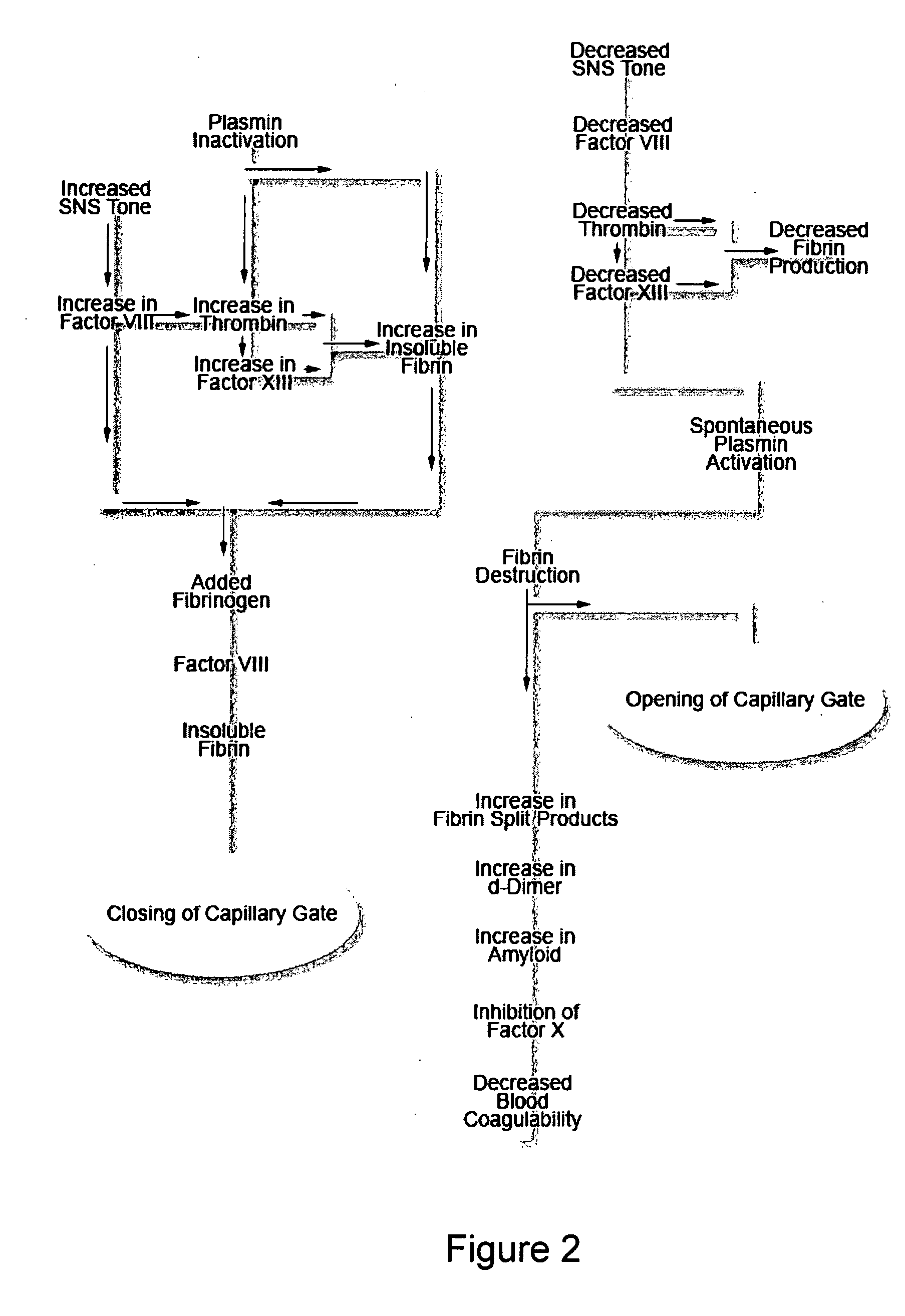Method of providing anesthesia
a technology of anesthesia and anesthesia chamber, which is applied in the field of providing anesthesia, can solve the problems of no attempt to describe a single mechanism, increased risk of thromboembolism in the venous system, pathological effects, etc., and achieves the effects of inhibiting blood clot formation, and reducing the risk of thromboembolism
- Summary
- Abstract
- Description
- Claims
- Application Information
AI Technical Summary
Benefits of technology
Problems solved by technology
Method used
Image
Examples
example 1
SIRS, ARDS, & Multi-Organ Failure
[0125] Systemic Inflammatory Response Syndrome (SIRS) has five identified components: (1) vasodilation, (2) increased microvascular permeability, (3) increased leukocyte and (4) platelet activation and (5) adhesion, and hypercoagulability. SIRS tends to be associated with conditions of stress, such as trauma, sepsis, pancreatitis, and burns. Multi-Organ Failure Syndrome (MOFS), also a Critical Care phenomenon associated with sepsis and trauma which is frequently observed in the Intensive Care Unit, is associated with the same types of extreme stress and exhibits similar symptoms. These syndromes may be closely related stress states which are caused by activation of Factors VII and VIII. SIRS may be explained by relatively greater activation of Factor VII, causing inflammatory effects to predominate, and MOFS may be explained by relatively greater activation of Factor VIII, thereby causing the effects of hyper-elevations of blood fibrin levels to pre...
example 2
Shock
[0127] The present invention recognizes that shock states, including cardiogenic shock, septic shock, and hypovolemic shock, are caused by combinations of stress-related closure of the Capillary Gate which in turn cause increased systemic vascular resistance and CFS and low cardiac output. The SNS may regulate closure of the Capillary Gate so as to direct limited cardiac output preferentially to vital organs, such as the heart and brain to preserve life, while other tissues may suffer hypoxic damage due to exaggerated CFS under such circumstances. Shock states are associated with elevations of SNS tone, systemic vascular resistance, Factor VIII, blood viscosity and coagulability, and blood levels of insoluble fibrin. “Second Tier” organs such as kidneys and bowel that normally require high perfusion rates may be particularly vulnerable to CFS under such circumstances; and the stress-related elevations in blood levels of insoluble fibrin may explain the renal “casts”, acute tub...
example 3
[0128] Normal pregnancy is a stressful condition that is associated with above-normal levels of Factor VIII and blood coagulability. It is associated with other stress-related conditions, such as diabetes, and may aggravate these conditions. Eclampsia is a stress state that involves levels of blood coagulability and Factor VIII that are elevated above those of normal pregnancy; and the severity of eclamptic symptoms mirrors the elevations in Factor VIII and blood coagulability. A common source of additional stress that may convert a normal pregnancy into an eclamptic state is sepsis resulting from pyelonephritis. The risk of eclampsia is increased by the presence of other stress states, such as diabetes. In the most severe manifestation of eclampsia, known as HELLP Syndrome, a severe risk of DIC exists that may be initiated by amniotic fluid embolus; and visible fibrin deposits appear in various organs, thereby causing disturbed organ function. Fibrin deposition on placent...
PUM
| Property | Measurement | Unit |
|---|---|---|
| molecular weight | aaaaa | aaaaa |
| psychic stress | aaaaa | aaaaa |
| somatic stress | aaaaa | aaaaa |
Abstract
Description
Claims
Application Information
 Login to View More
Login to View More - R&D
- Intellectual Property
- Life Sciences
- Materials
- Tech Scout
- Unparalleled Data Quality
- Higher Quality Content
- 60% Fewer Hallucinations
Browse by: Latest US Patents, China's latest patents, Technical Efficacy Thesaurus, Application Domain, Technology Topic, Popular Technical Reports.
© 2025 PatSnap. All rights reserved.Legal|Privacy policy|Modern Slavery Act Transparency Statement|Sitemap|About US| Contact US: help@patsnap.com



